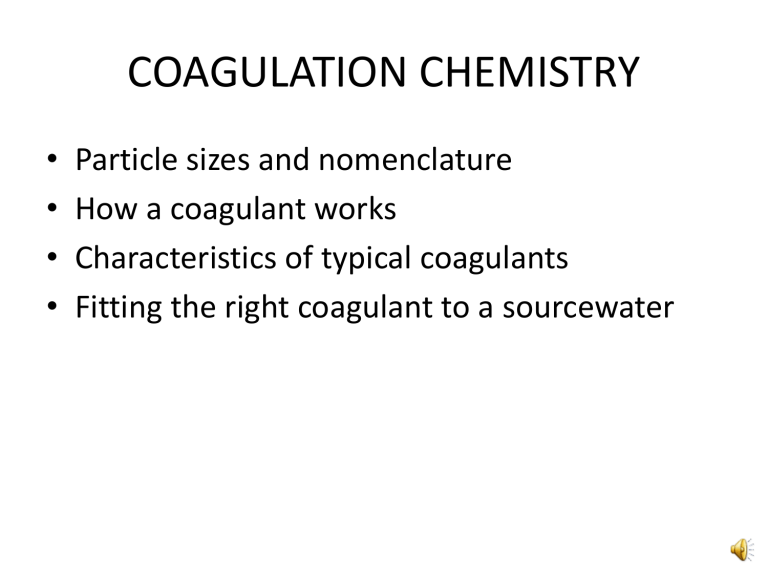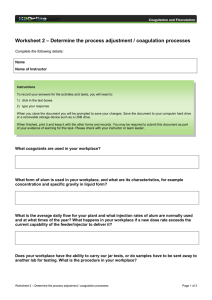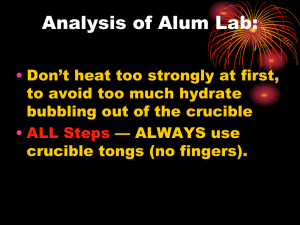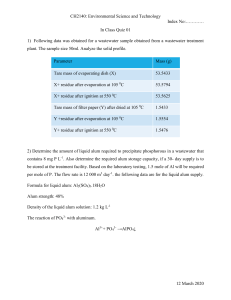
COAGULATION CHEMISTRY • • • • Particle sizes and nomenclature How a coagulant works Characteristics of typical coagulants Fitting the right coagulant to a sourcewater Log Scale of Distance (meters) E scope atoms colloids Opt scope bacteria Naked eye sand .003m .00000001 .0000001 .000001 .00001 10-8 10-7 10-6 10-5 µm micrometer .0001 10-4 0.03m 0.3 m .001 .01 .1 -3 -2 10 10 10-1 mm cm millimeter centimeter •Basketball ~0.3m •Golf ball ~ 0.03m •Gravel Particle ~ 0.003m •Sand Particle ~ 0.0003m or .3mm •Coliform Bacteria ~ 10-6m or 1µm •Colloids ~ 10-8 • Atoms ~1 to 5*10-10m (1 angstrom = 10-10m 1 100 m meter Charge Neutralization - - - -- - - - - - - - - - - Negative charged Stable Colloid + ++ + Al + ++ Al + ++ Al + ++ Al + Positively Charged Aluminum - - + ++ - Al -+ + + + ++ Al - - - Al - - + ++ Al Larger “floc” Charge-alanced •High Surface area on colloid, usually negatively charged (water applications) •Not stoichiometric…too variable in composition and charge characteristics •Can’t be “balanced” •Feedrates determined by jar tests and particle charge characteristics (Zeta Potential) In coagulation, the valence state electrons are important in “compressing” the repulsive forces between particles. For negatively-charged particles, Aluminum and Iron are particularly effective in their 3+ valence state. Flocculation + ++ -- - + +-+ - Al + ++ + ++ - - +- + + + ++ Al Al Al - Al + + + + ++- - +-+- + - Al + ++ Al + ++ Al -- + + + - -Al Al + ++ + +- + - - - Al - Al + + + Al - -- - - - -Al - + + + - - --- - - - Al - - -- - -- - - - -- Large particles Destabilized Mixing particles energy Al dense enough to sink Coagulation Theories • Chemical charge neutralization – Charges on the colloid are neutralized to allow particles to aggregate • Physical charge-layer compression – – – – – repulsive forces are complex Adsorption and charge neutralization are active “bridging” of coagulant complexes occur “enmeshment” processes can be significant Higher valence state chemicals are very effective in compressing the repulsive forces Coagulation/Flocculation • Effective in removing: – Bacteria – soil particles, – color, – organic material that react with chlorine to form DBPs – Arsenic Aluminum Coagulants • Alum Al2(SO4)3 . 14 H2O O O S O O Al O O S O O Al O O S O O • Minimum solubility – pH 5.5 • Precipitates as Al(OH) 3 ~(10-8 M) • Process works best at lower pH (6-7) O H Al O H Al2(SO4)3 + 14H20 + 3Ca(OH)2 O H 2Al(OH)3+3Ca(SO)4+14H2O+6CO2 • Each mg/l alum consumes 0.5 mg/l alkalinity Polyaluminum Chloride (PACl) • Al(OH)x(Cl)y • Polymerized, long chain chemical • Effective in bridging Ferric Coagulants • • • • Ferric Chloride FeCl3.6H2O Ferric Sulfate Fe2(SO4)3 . 9H2O Minimum Solubility ~pH 8 10-8M Works in a wider pH range , better than alum at pH 8 • Fe(H2O)6+3 +H2O = Fe(H2O)5(OH)+2 + H3O+ Polymers • Long-chain molecules • If charged, referred to as polyelectrolytes – Anionic polymers – Cationic polymers – Non-ionic polymers (no net charge) • Cationic (positive charge) works well on clay particles (negative charge) through bridging • Overfeeding can be a problem • Don’t affect pH…work well in low-alkalinity water with high turbidity So…what’s important? • Alum works best at lower pH values • The reaction consumes alkalinity – If you have a low alkalinity water (less than 60 to 80 mg/l as CaCO3), you may have to add alkalinity to get efficient coagulation – Lime or soda ash are the most commonly used chemicals to increase alkalinity • If you overfeed alum, you can get re-stabilization of the floc (and poor treatment performance) …more important stuff • Iron coagulants work across a wider pH range than alum (more forgiving of pH changes) • Iron flocs are heavier than alum floc, and thus iron works better in cold water conditions than alum (check the periodic table) • Polymers require far less quantity fed, but cost much more that alum and ferric. • Optimization is required to select best coagulant and mix…and this can change from season to season!





